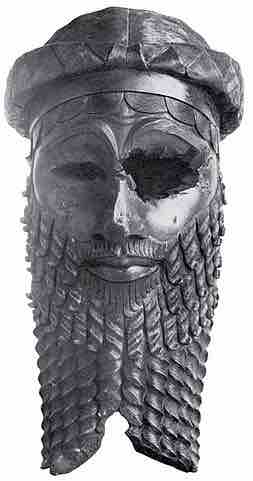The Akkadian Empire was an ancient Semitic empire centered in the city of Akkad, which united all the indigenous Akkadian speaking Semites and Sumerian speakers under one rule. The Empire controlled Mesopotamia, the Levant, and parts of Iran.

Map of the Akkadian Empire
The Akkadian Empire is pictured in brown. The directions of the military campaigns are shown as yellow arrows.
Its founder was Sargon of Akkad (2334–2279 BCE). Under Sargon and his successors, the Akkadian Empire reached its political peak between the 24th and 22nd centuries BCE. Akkad is sometimes regarded as the first empire in history.
Sargon and His Dynasty
Sargon claimed to be the son of La'ibum or Itti-Bel, a humble gardener, and possibly a hierodule, or priestess to Ishtar or Inanna. Some later claimed that his mother was an "entu" priestess (high priestess). Originally a cupbearer to king Ur-Zababa of Kish, Sargon became a gardener, which gave him access to a disciplined corps of workers who also may have served as his first soldiers. Displacing Ur-Zababa, Sargon was crowned king and began a career of foreign conquest. He invaded Syria and Canaan on four different campaigns, and spent three years subduing the countries of "the west" to unite them with Mesopotamia "into a single empire."
Sargon's empire reached westward as far as the Mediterranean Sea and perhaps Cyprus (Kaptara); northward as far as the mountains; eastward over Elam; and as far south as Magan (Oman)—a region over which he purportedly reigned for 56 years, though only four "year-names" survive. He replaced rulers with noble citizens of Akkad. Trade extended from the silver mines of Anatolia to the lapis lazuli mines in Afghanistan, and from the cedars of Lebanon to the copper of Magan. The empire's breadbasket was the rain-fed agricultural system of northern Mesopotamia (Assyria), and a chain of fortresses was built to control the imperial wheat production.
Sargon, throughout his long life, showed special deference to the Sumerian deities, particularly Inanna (Ishtar), his patroness, and Zababa, the warrior god of Kish. He called himself "the anointed priest of Anu" and "the great ensi of Enlil. "
Sargon managed to crush his opposition even in old age. Difficulties also broke out in the reign of his sons, Rimush (2278–2270 BCE), who was assassinated by his own courtiers, and Manishtushu (2269–2255 BCE), who reigned for 15 years. He, too, was likely assassinated in a palace conspiracy.

Bronze head of a king
Bronze head of a king, most likely Sargon of Akkad but possibly Naram-Sin. Unearthed in Nineveh (now in Iraq).
Naram-Sin
Manishtushu's son and successor, Naram-Sin (called, Beloved of Sin) (2254–2218 BCE), assumed the imperial title "King Naram-Sin, King of the Four Quarters." He was also, for the first time in Sumerian culture, addressed as "the god of Agade (Akkad)." This represents a marked shift away from the previous religious belief that kings were only representatives of the people toward the gods.
Naram-Sin conquered Ebla and Armum, and built a royal residence at Tell Brak, a crossroads at the heart of the Khabur River basin of the Jezirah. Naram-Sin also conquered Magan and created garrisons to protect the main roads. This productive period of Akkadian conquest may have been based upon benign climatic conditions, huge agricultural surpluses, and the confiscation of the wealth of other peoples.
Stele of Naram-Sin
This stele commemorates Naram-Sin's victory against the Lullubi from Zagros in 2260 BCE. Naram-Sin is depicted to be wearing a horned helmet, a symbol of divinity, and is also portrayed in a larger scale in comparison to others to emphasize his superiority.
Living in the Akkadian Empire
Future Mesopotamian states compared themselves to the Akkadian Empire, which they saw as a classical standard in governance. The economy was dependent on irrigated farmlands of southern Iraq, and rain-fed agriculture of Northern Iraq. There was often a surplus of agriculture but shortages of other goods, like metal ore, timber, and building stone. Art of the period often focused on kings, and depicted somber and grim conflict and subjugation to divinities. Sumerians and Akkadians were bilingual in each other's languages, but Akkadian gradually replaced Sumerian. The empire had a postal service, and a library featuring astronomical observations.
Collapse of the Akkadian Empire
The Empire of Akkad collapsed in 2154 BCE, within 180 years of its founding. The collapse ushered in a Dark Age period of regional decline that lasted until the rise of the Third Dynasty of Ur in 2112 BCE. By the end of the reign of Naram-Sin's son, Shar-kali-sharri (2217-2193 BCE), the empire had weakened significantly. There was a period of anarchy between 2192 BC and 2168 BCE. Some centralized authority may have been restored under Shu-Durul (2168-2154 BCE), but he was unable to prevent the empire collapsing outright from the invasion of barbarian peoples, known as the Gutians, from the Zagros Mountains.
Little is known about the Gutian period or for how long it lasted. Cuneiform sources suggest that the Gutians' administration showed little concern for maintaining agriculture, written records, or public safety; they reputedly released all farm animals to roam about Mesopotamia freely, and soon brought about famine and rocketing grain prices. The Sumerian king Ur-Nammu (2112-2095 BCE) later cleared the Gutians from Mesopotamia during his reign.
The collapse of rain-fed agriculture in the Upper Country due to drought meant the loss of the agrarian subsidies which had kept the Akkadian Empire solvent in southern Mesopotamia. Rivalries between pastoralists and farmers increased. Attempts to control access to water led to increased political instability; meanwhile, severe depopulation occurred.
After the fall of the Akkadian Empire, the Akkadian people coalesced into two major Akkadian speaking nations: Assyria in the north, and, a few centuries later, Babylonia in the south.